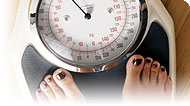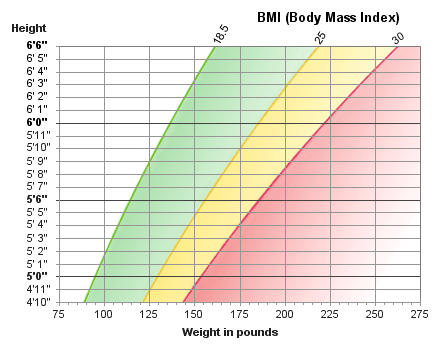health guides
How Much Should I Weigh?

People are often concerned about their weight because fashion trends and celebrities’ physical appearances influence popular body-image ideals—but these ideals do not necessarily represent healthy weight ranges.
Since people usually increase their body fat when they gain weight, overweight often leads to health risks. However, not all weight gain represents excessive fat. Weight gain in bodybuilders, for example, is due to increases in muscle that is part of the body’s lean mass, and there is no evidence that increased lean body mass is unhealthy. Similarly, weight gain during pregnancy is a natural and essential process for supporting foetal growth. Health concerns about overweight are actually concerns about the effects of excess body fat on disease or the risk of disease.
How do I know if my weight is affecting my health?
In 1998, a report containing the conclusions of a panel of health experts set guidelines for deciding when excess weight should be considered a health risk. They determined that three pieces of information were needed to decide whether weight loss should be recommended to improve current and future health:
- Body weight compared to height
- Waist circumference
- Presence or risk of cardiovascular disease
Body weight compared to height
Health professionals currently use the Body Mass Index (BMI) to estimate the health risks associated with being overweight or underweight. BMI is calculated by one of the following methods:
- BMI = weight in kilograms/(height in meters squared)
- BMI = [weight in pounds/(height in inches squared )] x 703
Body Mass Index chart
You can also obtain a simple measurement of BMI using following chart. Find your height in the left-hand column, then follow the bottom row to the right until you reach your weight. From left to right, the four chart areas show the ranges of low, normal, high, and very-high BMI.
 |
Body Mass Index values
The Body Mass Index is only one tool for assessing health risks associated with weight. To learn more, read this full article and see a health professional for a more precise assessment.
BMI Values:
- 18.5 or less: Low BMI (underweight)
- 18.5 to 24.9: Medium BMI (normal weight)
- 25 to 29.9: High BMI (overweight)
- 30 and above: Very-High BMI (obese)
Note: For a very muscular person, a high BMI does not necessarily indicate overweight, since the extra weight might be muscle, rather than fat.
Waist circumference
Abdominal fat has been recognised as the type of fat leading to the highest health risks compared with fat located elsewhere in the body. Waist circumference is considered a good indication of the amount of abdominal fat a person is carrying.
To measure waist circumference, the top of the upper-right hip bone (known as the iliac crest) is marked and a measuring tape is passed around the abdomen at this level. The tape should be snug but should not compress the skin, and the waist circumference measurement should be made at the end of a normal breath following exhalation.
Presence or risk of weight-related disease
People with weight-related diseases such as cardiovascular disease, and those who have high risk for those diseases, may need to lose weight, even if they are only moderately overweight, in order to promote optimal health.
If you have been told you have coronary heart disease, symptomatic carotid artery disease, peripheral arterial disease, abdominal aortic aneurysm, type 2 diabetes, or sleep apnea, you are in the high-health-risk category for the purpose of determining whether you should lose weight. You are also in this category if you have any two or more of the following heart disease risk factors:
- You are a male aged at least 45 years.
- You are a female aged at least 55 years or you are a postmenopausal woman.
- One or more members of your immediate family (parents or siblings) had premature severe heart disease. Premature means before age 55 in a male relative or before age 65 in a female relative. Severe heart disease means either a heart attack or sudden death assumed to be heart-related.
- You are a cigarette smoker.
- You have been told you have high blood pressure or you are taking antihypertensive medication.
- You have high blood levels of LDL (low density lipoprotein or “bad”) cholesterol.
- You have low blood levels of HDL (high density lipoprotein or “good”) cholesterol.
- You have high blood levels of glucose (elevated fasting glucose).
Some less serious diseases are also related to excess weight, and overweight people with these diseases are usually advised to lose weight. These diseases include gallbladder disease, osteoarthritis, stress incontinence, and gynaecological problems such as excessive menstrual bleeding (menorrhagia) and loss of menstrual periods (amenorrhoea). Consult your doctor to find out whether any other health problem you have is related to excess weight.
Who should lose weight to improve their health?
According to the report of the expert panel in 1998, people should lose weight if they fit any of the following descriptions using the above measures of weight, waist circumference, and health risks:
- A BMI of 30 or above
- A BMI of 25 or above in people with existing cardiovascular disease or other diseases associated with excess weight
- A BMI of 25 or above in people with two or more heart disease risk factors
- High-waist circumference (greater than 35 inches (88 cm) in women or 40 inches (102 cm) in men) in people with existing cardiovascular disease or other diseases associated with excess weight
- High-waist circumference (greater than 35 inches (88 cm) in women or 40 inches (102 cm) in men) in people with two or more heart disease risk factors
Are there other ways for measuring excess weight or excess body fat?
Height-weight charts such as those published by the Metropolitan Life Insurance Company were once popular for determining appropriate body weight. However, these charts have been criticized because they were based on risk of death rather than disease, and because they were not representative of the entire population of men and women.
Since health concerns about overweight are actually concerns about the effects of excess body fat on disease or the risk of disease, it could be useful to measure body fat directly. A few methods for measuring body fat are available in health clinics, fitness centres, college athletic departments, and other facilities. All of the following can be reliable for estimating body fat if the person performing the measurement is well-trained and if the equipment is of good quality and in optimum working condition:
- Measurements of fat under the skin. These are done with skinfold calipers, or infrared or ultrasound devices. A few measurements must be taken at different locations on the body for the best accuracy.
- Measurements of whole body size and density. The most common methods used are underwater (“hydrostatic”) weighing and air-displacement plethysmography (e.g., the “BOD POD”).
- Bioelectric impedance analysis. In this method a low-grade, imperceptible electrical current is sent through the body, and changes in this current are measured and used to calculate lean body mass and body fat. Methods that measure current from wrist to foot are considered more accurate that those that measure current between both hands or both feet.
Although the above methods are considered potentially reliable for estimating body fat, no well-researched guidelines exist for determining what levels of body fat are detrimental to health, and there is no agreement about how to use these measurements to decide when weight loss should be recommended. Excessive percentage body fat has been suggested to begin at 21 to 25% for men and 31 to 32% for women depending on the authority, but more research is needed to confirm this.
Is focusing on weight loss the best way to address the health risks of excess weight?
Some authorities believe that too much public health emphasis is placed on losing excessive weight instead of focusing on the promotion of a healthy lifestyle, including diet, exercise habits, and other behaviours that reduce the risk of disease. They point out that not all obese people have increased health risks, and that weight-loss programmes frequently fail in the long term, or result in only an insignificant amount of weight loss. At the same time, healthy lifestyle changes often result in a reduction in disease risk and other important health benefits, even if weight change is not impressive.
Copyright © 2024 TraceGains, Inc. All rights reserved.
Learn more about TraceGains, the company.
Information expires December 2024.


 We are proud to announce that
We are proud to announce that  As the market evolves, customers increasingly request a wider variety of omega-3 options for their lipid...
As the market evolves, customers increasingly request a wider variety of omega-3 options for their lipid...  Maintaining healthy glucose levels is crucial for preventing metabolic conditions like diabetes,...
Maintaining healthy glucose levels is crucial for preventing metabolic conditions like diabetes,...  Looking at formulating a new vitamin blend? Discover
Looking at formulating a new vitamin blend? Discover 







































